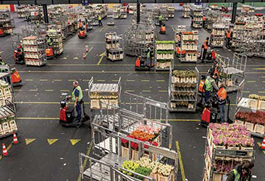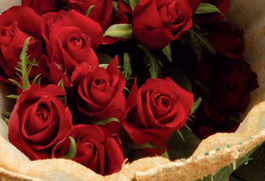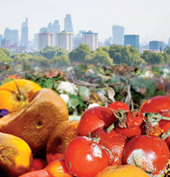Africa 2018 Focusses on Benchmarking Cold Chain Logistics and Technology The third edition of Flower Logistics Africa had a full house representing a crosssection of
Author: admin
 Panalpina has doubled its cold storage space at Nairobi’s Jomo Kenyatta International Airport, with the aim of growing the perishable volumes flown out of Kenya. The facility has been expanded by 1,500 m2 and offers Jomo Kenyatta International Airport’s only dedicated loading bays for skidded or palletised cargo and with separate cold rooms to manage specific temperature requirements. Panalpina aims to grow its business in Kenya from the current 65,000 tons of flowers, fruits, and vegetables it moves, to more than 80,000 by 2020.
Panalpina has doubled its cold storage space at Nairobi’s Jomo Kenyatta International Airport, with the aim of growing the perishable volumes flown out of Kenya. The facility has been expanded by 1,500 m2 and offers Jomo Kenyatta International Airport’s only dedicated loading bays for skidded or palletised cargo and with separate cold rooms to manage specific temperature requirements. Panalpina aims to grow its business in Kenya from the current 65,000 tons of flowers, fruits, and vegetables it moves, to more than 80,000 by 2020.
“This facility will provide many business opportunities for our customers to pursue in [Kenya], the region and the world, and that is what we are looking to achieve – solutions that foster growth for our customers, Panalpina and the communities where we operate,” said Stefan Karlen, president and chief executive of Panalpina.
The company has been expanding its presence in the perishables market over the last few years, with the sector seen as useful for providing regular and consistent back-haul traffic. Panalpina first started operations in Nairobi in 2015 with a team of five people, which soon grew to 200 with the acquisition of Airflo, and later to 350 with that of Air Connection.
Unless the two bickering parties in this messy divorce reach an agreement bringing about some less disruptive arrangement, goods travelling across the channel are likely to confront customs
Summary
- The European Union has a trade agreement with Kenya that enables imports of flowers free of tariffs.
- After Brexit, Britain will have to negotiate its own arrangement with Kenya and other exporters.
- Until a deal is struck, flowers sent from Kenya to Britain would stand to incur tariffs of nearly 7 percent, a potential shock for an industry that has become a major source of jobs in the East African nation. checks and sanitary inspections.
 Far removed from the political posturing and brinkmanship that capture most of the attention in Britain’s long and tedious departure from the European Union, Yme Pasma is deeply enmeshed in the mother of all logistical problems.
Far removed from the political posturing and brinkmanship that capture most of the attention in Britain’s long and tedious departure from the European Union, Yme Pasma is deeply enmeshed in the mother of all logistical problems.
He is the chief operating officer of Royal FloraHolland, a marketplace where some 12 billion flowers and plants are sold a year — more than one-third of the worldwide trade in such blooms. Inside hulking warehouses near Amsterdam’s Schiphol airport in the town of Aalsmeer, Royal FloraHolland operates a flower auction and a distribution centre.
A fleet of computer-guided forklifts whisks buckets of roses, boxes of amaryllis and other foliage — some grown in Holland, some flown in from Africa, Asia and Latin America — toward loading docks, to be placed on trucks and shipped to customers worldwide.
The scent of flowers is pervasive, a weirdly anomalous whiff of perfume amid the clatter of machinery.
Nearly $1 billion worth of this product a year is destined for the United Kingdom, a realm that today is still part of the European Union. Flowers arriving from outside Europe can clear customs and then proceed unhindered to Britain.
Summary
- The decision by KQ to dedicate the New York route to passengers, with only five tonnes allocated to cargo, means Kenya’s flower industry cannot penetrate the US market.
- There is also the issue of the return flight flying back empty because Kenya’s main imports from the US are bulk machinery, cereals and aircraft that are shipped here.
- The emergence of new cut flower producers, particularly Ethiopia, is causing jitters that Kenya’s dominance is diminishing, albeit slowly.
 In spite of optimism and excitement after national carrier Kenya Airways (KQ) started direct flights to the US in October, the airline’s business strategy of focusing on passengers as opposed to cargo has dashed the hopes of the flower industry of targeting the market that has remained elusive.
In spite of optimism and excitement after national carrier Kenya Airways (KQ) started direct flights to the US in October, the airline’s business strategy of focusing on passengers as opposed to cargo has dashed the hopes of the flower industry of targeting the market that has remained elusive.
This is bad news for the industry which despite being the second leading foreign exchange earner after tea, is grappling with a myriad of challenges that are threatening the country’s position as Africa’s leading producer of cut flowers.
The sector is currently dealing with challenges ranging from a fertiliser importation crisis, increase in input taxes, delays in tax refunds, stringent phytosanitary requirements in the European Union (EU) market, new demands on fumigation by key market Australia to intensifying competition from emerging flower producers like Ethiopia, Rwanda, Uganda and Tanzania.
In the midst of these predicaments, the decision by KQ to dedicate the new route specifically to passengers, with only five tonnes allocated to cargo, means the flower industry cannot count on the national carrier to penetrate the US market.
How two Exhibitions Running Concurrently Are Changing Today’s Market
 IFTF 2018
IFTF 2018
From November 7-9, the IFTF took place in Vijfhuizen, the Netherlands. Nearly 300 companies showcased their varieties and services, attracting visitors from all over the world. Every year, the cut flower show is becoming bigger and the number of visitors is increasing. Also this year, the visitor number was about 15% higher compared to last year. And for next year further international growth is expected as a new pavilion will be added: Argentina.
Neat booths
When entering the show, one of the first things – next to the increased exhibition area – that strikes the attention are the neat stands. It seems that many exhibitors took their time and effort to pay attention to the little details and have put up a professional neat-looking stand.
Fresh flowers need the best in packaging solutions to make sure they arrive at their destination in peak condition and our innovative packaging solutions deliver just that. For the export market, packaging is especially designed to provide the required amount of water resistance, strength and insulation to meet the physical requirements of your supply chain, whether you are shipping your flowers by road or by air.

What is sustainable packaging?
The concept of sustainable packaging includes a wide range of environmentally friendly practices, designs and materials that integrates the entire supply chain. The objective is to improve the longevity and quality of our environment by decreasing pollution caused by plastics and other non-degradable materials.
 You’ve probably heard the widely-quoted factoid that the majority of food waste happens in the home. From grocery over-purchasing to over-zealous expiration dates to just plain forgetting to cook that cabbage you bought, it’s not exactly a surprise that the kitchen is where a lot of needless wastage takes place.
You’ve probably heard the widely-quoted factoid that the majority of food waste happens in the home. From grocery over-purchasing to over-zealous expiration dates to just plain forgetting to cook that cabbage you bought, it’s not exactly a surprise that the kitchen is where a lot of needless wastage takes place.
So where does the rest of our food waste occur? According to the Food and Agriculture Organization, when it comes to fresh produce (the most wasted foods, at least in industrialized countries), almost 1/3 happens along the supply chain. From lack of coordination and communication to inconsistent quality standardization, there are plenty of things that need to go right to get fresh food from A to B without it spoiling — and that doesn’t always happen.
However, there are a few tools and strategies that companies are using to try and reduce food waste at various points along the supply chain. Here are three to watch:
 While the ideal of integrated pest management has been pursued and adopted in a variety of settings since the mid-20th century, recent trends point to perhaps too great a focus on killing pests rather than managing host stress. In a new paper in American Entomologist, three experts suggest a modified focus that better accounts for evolution and tolerance to pest injury and shifts from control toward management.
While the ideal of integrated pest management has been pursued and adopted in a variety of settings since the mid-20th century, recent trends point to perhaps too great a focus on killing pests rather than managing host stress. In a new paper in American Entomologist, three experts suggest a modified focus that better accounts for evolution and tolerance to pest injury and shifts from control toward management.
By Robert K.D. Peterson
Whatever happened to integrated pest management? If you’re a regular reader of Entomology Today, you might think “Why, I didn’t know anything had happened to it.” So, why is anyone even asking this question?
It’s true that integrated pest management (IPM) is a term well known. It is used liberally by scientists and other practitioners without the need for definition, and it is a major success story for society. But it can also be argued that IPM has, in fact, lost its way.
There has been little formal discussion of IPM theory and its status over at least the past 10 years, even though in that time we have seen both the overwhelmingly successful adoption of prophylactic pest control tactics in the form of transgenic crops and seed treatments and the increasing application of evolutionary biology in environmental and public health management.
Bridges the Gap Between Supplier and Grower What is your personal back ground? I am an agronomist and marketer with diverse experience in the agriculture
 Flowers are the perfect gift for someone close to the heart but geographically distant, i.e. theoretically an ideal e-commerce market.
Flowers are the perfect gift for someone close to the heart but geographically distant, i.e. theoretically an ideal e-commerce market.
However, they are also a delicate and perishable commodity, typically requiring hydration during transportation and lasting only four or five days in conventional packaging.
Flexible packaging specialist Uflex gained much attention with the recent release of its Flexfresh solution, which promises waterless transportation with significantly extended product life. Siva Shankaran (VP, Flexfresh) discusses the contexts .
“Internationally, all flowers are transported using expensive air freight from growing region to the markets,” observes Mr Shankaran. “The typical supply chain is grower – auction house – wholesaler – retailer / florist – and finally the consumer. Thanks to e-commerce platforms it’s now possible to connect the growers directly to the consumers. Our concept was to to ship flowers in post parcels without any water. This eliminated the possibility of cross contamination with other courier goods.”
